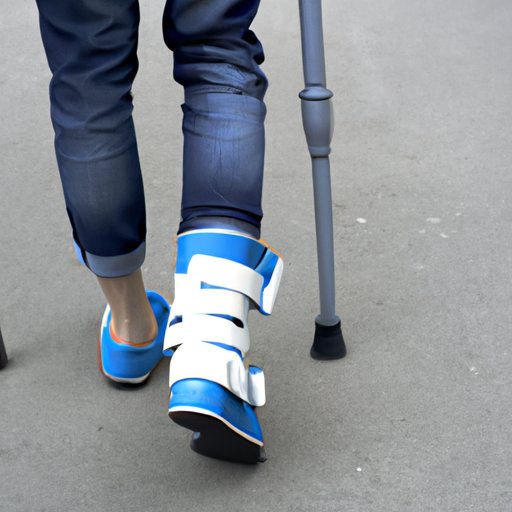
I. Introduction
Stress fractures are tiny cracks in the bone, caused by repetitive stress on the foot. They are common among athletes and people who engage in high-impact activities. While stress fractures can be painful and limiting, proper management can lead to full recovery. In this article, we’ll explore whether walking with a stress fracture in the foot is possible and what steps you should take to ensure proper healing.
II. The Do’s and Don’ts of Walking with a Stress Fracture in Your Foot
If you have a stress fracture in your foot, it’s important to take proper precautions when walking to avoid further injury. Here are some Do’s and Don’ts:
Do’s:
- Use proper footwear
- Start with short walks
- Listen to your body
- Gradually increase activity levels
Don’ts:
- Engage in high-impact activities
- Ignore pain
- Delay proper treatment
- Put too much stress on your foot
III. How to Stay Active While Recovering from a Stress Fracture in Your Foot
Although rest is important during the recovery process, it’s also essential to stay active to promote healing and maintain overall health. Low-impact exercises that can aid recovery include swimming, cycling, and yoga. Here are some tips for gradually increasing activity levels:
- Start with non-weight-bearing exercises
- Gradually add weight-bearing exercises
- Maintain a healthy diet to support bone recovery
IV. The Risks of Walking on a Stress Fracture and How to Properly Heal
Walking on a stress fracture can increase the risk of further injury and prolong the recovery process. Common complications include chronic pain, reinjury, and permanent damage. To properly heal a stress fracture, follow these steps:
- Rest and immobilize the affected foot
- Apply ice to reduce swelling and inflammation
- Use crutches or a walking boot if necessary
- Seek medical intervention if pain persists or worsens
V. Walking vs Resting with a Stress Fracture: Which is Best?
There’s still debate about whether to walk or rest with a stress fracture. Walking can promote blood flow and aid the healing process, but it can also exacerbate the injury. Resting can prevent further damage but may also lead to muscle atrophy and slowed healing. To find a balance between rest and activity, it’s best to consult with a medical professional.
VI. Managing Pain While Walking with a Stress Fracture in Your Foot
Managing pain is an essential part of the recovery process. Common strategies include over-the-counter pain medication, ice therapy, and physical therapy. It’s important to follow medical advice and never exceed recommended dosages.
VII. Tips for Preventing a Stress Fracture from Worsening While Walking
To avoid worsening the injury while walking, it’s essential to take proper care of your feet and legs. This includes maintaining proper posture, using the correct footwear, and warming up before exercise. Proper nutrition is also important for bone health.
VIII. Alternatives to Walking with a Stress Fracture: Low-Impact Exercises for Recovery
If walking is not possible during the recovery process, there are still plenty of low-impact exercises that can promote healing. Swimming, cycling, and water aerobics are all good options. These exercises can help maintain cardiovascular health and encourage the healing process.
IX. Conclusion
A stress fracture in the foot can be frustrating and limiting, but with proper management, it’s possible to make a full recovery. Follow these tips to ensure you heal properly, avoid further injury, and stay active during the recovery process. As always, consult a medical professional for individualized recommendations.




